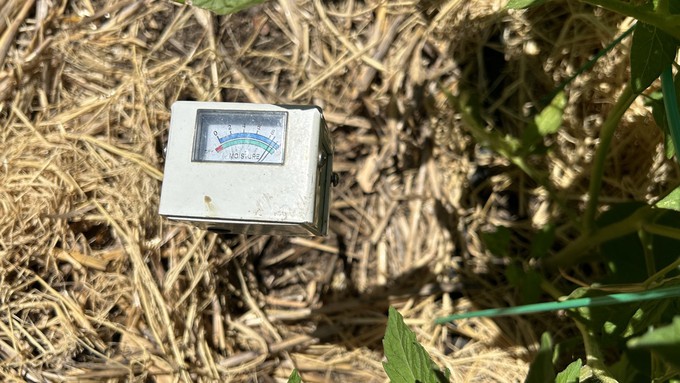
With 100-degree days coming soon, these tips will save your plants

The soil looks dry on top, but the moisture meter shows that it's plenty wet down at the roots. Kathy Morrison
Well, we knew our cool weather wouldn’t last. Triple-digit days are on their way – just in time for a red-hot Fourth of July weekend.
According to the National Weather Service, the Sacramento region can expect highs of 100 to 110 degrees this weekend, peaking on Saturday, July 1.
“An Excessive Heat Watch is in effect from 11 AM Friday to 11 PM Sunday for the Valley and foothills,” tweeted the NWS Sacramento office on Tuesday morning. “These are the highest temps we've seen this year! With this happening during the holiday weekend, NOW is the time to prepare: Have a way to stay cool & hydrated!”
Thursday could be the first of several triple-digit days. Friday’s forecast calls for 103 in downtown Sacramento and 105 on Saturday. That’s almost a 30-degree leap from Sunday, June 26, which recorded a high of only 76 degrees.
This first real heat of summer could take a toll on your garden. Your new transplants aren’t used to these extremes.
Before that first 100-degree day, prepare your garden – and yourself – for the heat ahead:
* Stay hydrated! That applies to both you and your garden. Water early in the day – before 8 a.m. if possible – to cut down on evaporation.
* Cycle and soak. Water needs a chance to soak in, especially if you have clay soil. Otherwise, it will run off (and down the drain) instead of reaching roots. Run your irrigation for a short period. Wait an hour or two. Then, run your system again. The water from the second cycle will reach deeper than the first.
* Mulch, mulch, mulch! A layer of 3 inches of straw, wood chips, dried leaves or other organic material will keep soil and roots cooler while conserving moisture.
* Shade sensitive plants and developing fruit on tomatoes, peppers, eggplant and squash. Your harvest can get sunburned. Protect from intense afternoon rays with temporary shade such as burlap draped over trellises.
* Wilting can be normal. Some big-leafed plants such as squash may seem to wilt every hot afternoon; that’s OK. They recover overnight. It’s when they’re still wilted in the morning that it’s a problem.
* Check the soil before you water. It may look dry on top, but still have enough moisture in the root zone 6 inches below the surface. Plants can suffer from too much water (especially in containers) as well as not enough. But remember that containers dry out quickly in heat -- any hanging plants especially may need to be watered twice daily.
* Prioritize your watering. Deep-water trees and shrubs, which are your landscape’s most valuable and slowest-growing plants.
* Switch to drip. Drip irrigation puts water where plants need it – at the roots.
Heat is often on the minds behind Sacramento Digs Gardening. Here are links to several past columns with heat-related advice:
-- Get Ready for Hot Days Ahead
-- Mulch is Good, and More Mulch is Better
-- 5 Hacks for Shading Your Precious Vegetables
-- Hot Tomato! How to Help Your Vines During High Heat
-- Speaking for the Trees: Don't Forget Them in This Heat
-- For Best Roses in Heat, Watch Water and Mites
And if you’re too late:
-- Rescuing a Heat-Stressed Plant
Finally, for the gardener:
--- Too Hot to Think? Follow These Tips
– Debbie Arrington and Kathy Morrison
Comments
0 comments have been posted.Sacramento Digs Gardening to your inbox.
Food in My Back Yard Series
April 29: What's (already) wrong with my tomato plants?
April 22: Should you stock up on fertilizer? (Yes!)
April 15: Grow culinary herbs in containers
April 8: When to plant summer vegetables
April 1: Don't be fooled by these garden myths
March 25: Fertilizer tips: How to 'feed' your vegetables for healthy growth
March 18: Time to give vegetable seedlings some more space
March 11: Ways to win the fight against weeds
March 4: Potatoes from the garden
Feb. 25: Plant a fruit tree now -- for later
Feb. 18: How to squeeze more food into less space
Feb. 11: When to plant? Consider staggering your transplants
Feb. 4: Starting in seed starting
Sites We Like
Garden Checklist for week of May 4
Enjoy this spring weather – and get gardening!
* Plant, plant, plant! It’s prime planting season in the Sacramento area. Time to set out those tomato transplants along with peppers and eggplants. Pinch off any flowers on new transplants to make them concentrate on establishing roots instead of setting premature fruit.
* Direct-seed melons, cucumbers, summer squash, corn, radishes, pumpkins and annual herbs such as basil.
* Harvest cabbage, lettuce, peas and green onions.
* In the flower garden, direct-seed sunflowers, cosmos, salvia, zinnias, marigolds, celosia and asters. (You also can transplant seedlings for many of the same flowers.)
* Plant dahlia tubers. Other perennials to set out include verbena, coreopsis, coneflower and astilbe.
* Transplant petunias, marigolds and perennial flowers such as astilbe, columbine, coneflowers, coreopsis, dahlias, rudbeckia and verbena.
* Keep an eye out for slugs, snails, earwigs and aphids that want to dine on tender new growth.
* Feed summer bloomers with a balanced fertilizer.
* For continued bloom, cut off spent flowers on roses as well as other flowering plants.
* Add mulch to the garden to maintain moisture. Mulch also cuts down on weeds. But don’t let it mound around the stems or trunks of trees or shrubs. Leave about a 6-inch to 1-foot circle to avoid crown rot or other problems.